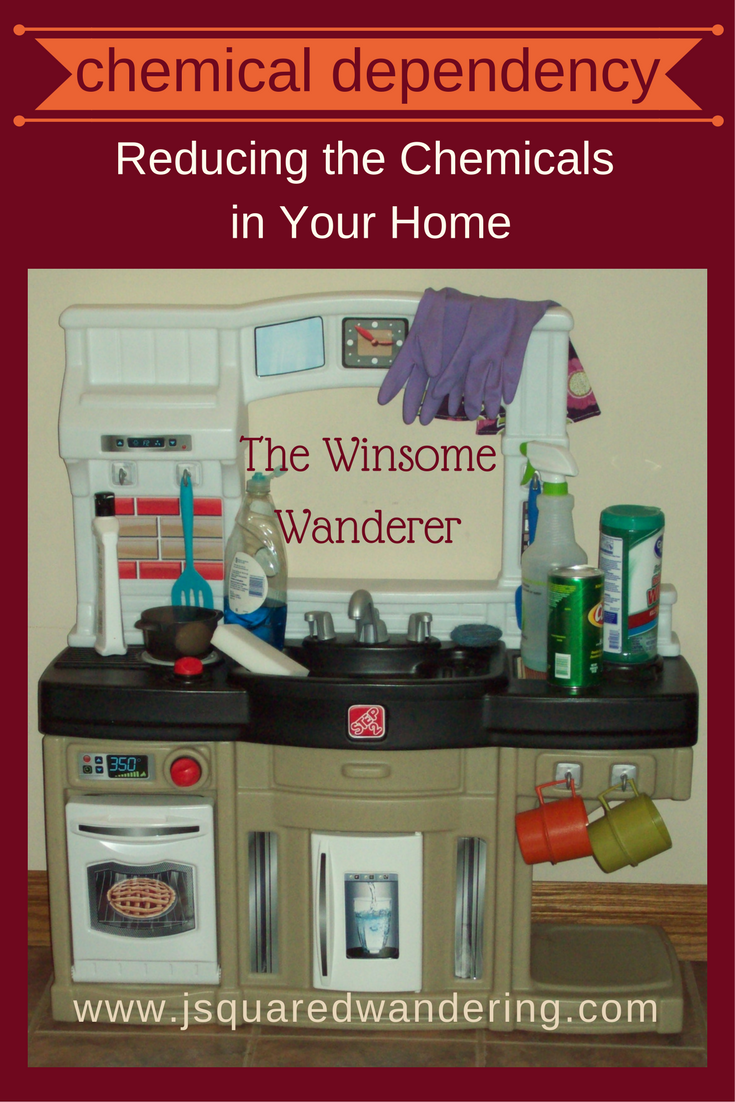Remember to Share on Facebook and Pinterest so others can enjoy too!
Chemical Dependency:
Reducing the Chemicals in your Home
“Let me preface this by stating that I don’t consider myself to be a health nut, or environmental activist, but rather a homemaker who wants to make her family’s environment as healthy as possible.”
About ten years ago, I had a revelation about my homemaking.
At the time, I had embarked on some dietary changes, and was reading labels. One day while cleaning, I thought, “Why not read the labels on my household cleaners?” I couldn’t find a list of ingredients anywhere. There were catch phrases on bottles such as “Now with Bleach!” but no list of ingredients.
“I had never noticed this before. “
However, I did notice on one of the bottles it said that you needed to rinse the surface (the one you just wiped down with this product) before using for food preparation. I hadn’t been doing that! I was horrified! I didn’t want to have to wipe my counters down twice each time, and I certainly didn’t want to worry if I missed any harmful residue!
“Never once had I thought about how chemicals lingered
on every surface or hung in the air!”
I used to spend my days spraying glass cleaner, surface cleaner, furniture polish, air freshener, and using sanitizing wipes, all in the name of good housekeeping. Not to mention the use of fragranced laundry detergent and fabric softeners! The air in my home was essentially a chemical stew! Change was in order!

I realized that I couldn’t just throw everything out at once. It wasn’t practical, and we were on a budget. I decided to replace them each as I used them up. So the next time I went shopping I headed for the section of “natural” cleaners. I was very discouraged when I saw the prices of the products. To some people that may not be a big deal, but if it matters to you, read on!
Instead, I purchased a bottle of white distilled vinegar. I remembered how my grandpa would use newspapers with vinegar and water to clean glass. This is still a great method because newspapers are streak free! However, I did not like how they turned my hands black. I’m picky. I know. I was not a Do It Yourself kind of girl, but so began my DIY cleaner journey. I kept the vinegar and water, but added some rubbing alcohol to cause quicker drying for that streak free finish. (Click here for the DIY Glass cleaner by Jo Wanderer – will open in a new tab. We will also have a link at the end of this article so feel free to read on.)
I continued creating homemade substitutions for each DIY cleaner I used. What I found was that you really don’t need as many cleaners as the chemical industry would like you to believe!
Shop For Cleaning Supplies, Storage and Hardware Products Today At The Lowest Prices!
Ingredient List for a DIY cleaner
To get started with healthier, DIY cleaning products, here is a list of items to have on hand:
• Distilled white vinegar
• Distilled or filtered water
• Isopropyl alcohol 70% or higher
• Baking soda
• Lemon juice, fresh or concentrated
• Dishwashing liquid of your choice (I like blue Dawn)
• Essential oils, lemon, lavender and/or tea tree
• Rags, micro fiber, or old t-shirts, cut up
• Old gift cards or credit cards
• Toothbrush
• Empty spray bottles, 16 oz. or larger
• Funnel
Micro fiber rags are great for lint free cleaning. Personally, old t-shirts are what I like to use since I feel like I can “afford” to throw them away if they get too dirty. Old gift cards make great scrapers. If you ever need to scrape gooey or crusty substances, these work wonders! Old or new, toothbrushes are for cleaning grout and narrow crevices. My favorite spray bottles are from the garden department at my store. Just make sure the bottles you use have markings on them for measuring. The funnel is just to make pouring ingredients easier. It’s not necessary, if you’re skillful!
Hang in there for part two in this series and enjoy your new DIY cleaner for glass products!
From my nest to yours,
Jo
Click here to download Jo Wanderer’s DIY Glass Cleaner Recipe. (Will open in a new tab.)



